#wife of King afonso iv of portugal
Text
Parallels between D. Pedro I of Portugal, "The Cruel" and Rhaenyra Targaryen "The Cruel".

As we know... Rhaenyra Targaryen, a character from George R.R. Martin's "A Song of Ice and Fire" series, and D. Pedro I of Portugal, a historical figure, share some parallels which i find extremely interesting!
Loss of their loved ones :
Rhaenyra Targaryen and D. Pedro I of Portugal experienced heart-wrenching losses that led to civil wars against their own family.
Rhaenyra Targaryen : Rhaenyra lost her son, Prince Lucerys Velaryon, by her half-brother Aegon II's supporters. These tragedie fueled Rhaenyra's determination to claim the Iron Throne, leading to the devastating civil war known as the Dance of the Dragons, where she fought against her half-brother and his supporters for control of the Seven Kingdoms.
D. Pedro I of Portugal : Pedro's love for his mistress, Inês de Castro, led to a tragic turn of events. His father, King Afonso IV of Portugal, disapproved of Pedro's relationship with Inês and ordered her assassination in 1355. This brutal act led Pedro to rebel against his father, sparking a civil war known as the Crisis of 1383–1385. Pedro sought vengeance for Inês's murder and contested his father's authority, ultimately leading to the overthrow of the Portuguese monarchy and the establishment of Pedro as King D. Pedro I of Portugal.
Both Rhaenyra and D. Pedro I's civil wars were deeply personal, fueled by love, loss, and a desire for justice or vengeance against their own family members. These conflicts underscored the complexities of power struggles within ruling families and the lengths individuals would go to in order to protect their loved ones and assert their rightful claims.
Struggles for Succession :
Both Rhaenyra and D. Pedro I faced challenges regarding succession.
Rhaenyra Targaryen : she fought to claim the Iron Throne of Westeros, facing opposition from her half-brother, Aegon II.
D. Pedro I of Portugal : was involved in a struggle for succession in Portugal, particularly against his father, King D. João VI, and his father's supporters.
Family Conflicts :
Both figures were embroiled in familial conflicts.
Rhaenyra Targaryen : Rhaenyra's claim to the throne sparked a civil war known as the Dance of the Dragons, pitting different branches of House Targaryen against each other.
D. Pedro I of Portugal : Pedro faced tensions within his own family, including conflicts with his father, as well as disputes with his wife, Infanta Carlota Joaquina.
Assertive Actions :
Rhaenyra and D. Pedro I both took assertive actions to secure their positions.
Rhaenyra Targaryen : Rhaenyra actively sought allies and military support to strengthen her claim to the throne.
D. Pedro I of Portugal : D. Pedro I engaged in strategic maneuvers and military actions to consolidate his power and assert his authority, notably during the Liberal Wars in Portugal.
Controversial Reigns :
Both figures had controversial reigns marked by conflict and instability.
Rhaenyra Targaryen : Rhaenyra's reign as queen was short-lived and tumultuous, characterized by the civil war that erupted over her claim to the throne.
D. Pedro I of Portugal : D. Pedro I's reign in Portugal was also marked by political unrest and conflict, including his involvement in the Liberal Wars and the struggle to establish a stable government.
The title "The Cruel" :
"The Cruel" as been associated with both Rhaenyra Targaryen and D. Pedro I of Portugal, though in different contexts.
Rhaenyra Targaryen : In George R.R. Martin's "A Song of Ice and Fire" series, Rhaenyra Targaryen is sometimes referred to as "Rhaenyra the Cruel." This epithet reflects her actions during the Targaryen civil war known as the Dance of the Dragons, where she displayed ruthlessness and brutality in her pursuit of power.
D. Pedro I of Portugal : Pedro I of Portugal is also known by the epithet "Pedro the Cruel" or "Pedro the Just." This title stems from his actions during the Crisis of 1383–1385, particularly his ruthless pursuit of vengeance for the murder of his beloved Inês de Castro. Pedro's actions during this time, including the execution of political opponents and enemies, earned him a reputation for cruelty among some contemporaries.
While Rhaenyra Targaryen is a fictional character and D. Pedro I of Portugal was a historical figure, their stories share intriguing parallels in terms of their struggles for power, familial conflicts, and controversial reigns.
I found this quite interesting, I hope you found it interesting too. 😁
#asoiaf#a song of ice and fire#a son for a son#rhaenyra targaryen#house targaryen#house of the dragon#hotd#game of thrones#got#daemon targaryen#lucerys velaryon#D.Pedro#Portugal#history
23 notes
·
View notes
Text
So there once was a woman named Inês de Castro
She was a lady-in-waiting of Constance of Castile a noblewoman
This noblewoman got married with Peter I king of Portugal
Apparently the marriage was arranged against their both will
They didn’t love each other
Instead the king fell in love with Inês
When the queen died King Afonso IV of Portugal, Pedro's father, tried to remarry his son
But Pedro refused to take a wife other than Inês, who was not deemed eligible to be queen
After several attempts to keep the lovers apart, Afonso IV ordered Inês' death
Enraged, Peter revolted against his father
Afonso defeated his son within a year, but died shortly thereafter, and Peter became king
According to legend, Peter later had Inês' body exhumed and placed upon a throne, dressed in rich robes and jewels
He also required all of his vassals to kiss the hand of the deceased "queen"
So now I cannot stop thinking about canon divers where Ed DID DIE
And Stede is so devastated and in grief that he cannot accept this reality
So, he pretends that Ed is still here still alive and well
He places his body on a chair and settee
Let’s make you comfortable love
He dresses him in best clothes
Red looks good on you dear
He gives him jewels and gold
Which one do you like most darling?
The whole crew including Izzy got the creeps but they exhausted and abused and don’t have enough willpower to contradict Stede on this one
Izzy thinks that it is deeply unhealthy but he’s on a guilt trip so he’ll let Stede have it
Especially because Stede asks his opinion how to make things better for “Ed”

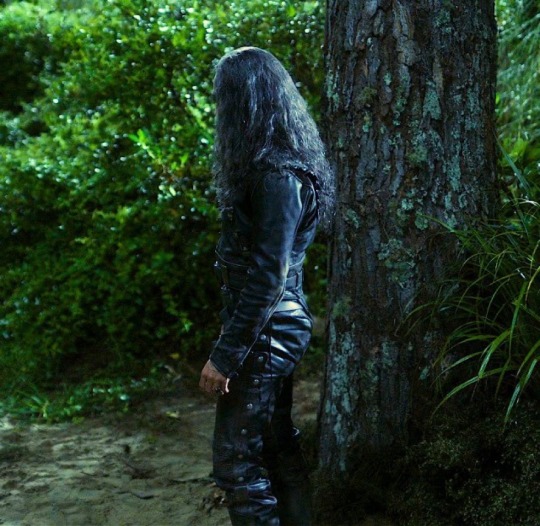
#stedward#gentlebeard#ofmd 2#ofmd#ofmd season 2#ofmd s2#stede bonnet#ofmd stede#stede fucking bonnet#ofmd edward teach#edward teach#ed x stede#blackbeard
18 notes
·
View notes
Text

Columbano Bordalo Pinheiro (1857-1929)
"Tragedy of Inês de Castro" (1901-1904)
Realism
Located in the Museu Militar de Lisboa, Lisbon, Portugal
Inês de Castro (1325-1355) was a Galician noblewoman and courtier, best known as lover and posthumously-recognized wife of King Peter I of Portugal. The dramatic circumstances of her relationship with Peter (at the time Prince of Portugal), which was forbidden by his father King Afonso IV, her murder on the orders of Afonso--she was decapitated in front of one of her young children—Peter's bloody revenge on her killers—he captured two of them and publicly executed them by ripping their hearts out, claiming they didn't have one after pulverizing his own heart—and the legend of the coronation of her exhumed corpse by Peter, have made Inês de Castro a frequent subject of art, music, and drama through the ages.
Inês and Peter also had several children, whom he would legitimize after her death. Afonso, died shortly after birth. John, Duke of Valencia de Campos, claimant to the throne during the 1383–85 Crisis. Denis, Lord of Cifuentes, claimant to the throne during the 1383–1385 Crisis. And Beatrice, who married Sancho Alfonso, 1st Count of Alburquerque, the great-grandmother of Ferdinand II of Aragon and thereby an ancestor of all Spanish monarchs.
#paintings#art#artwork#history painting#tragic love#columbano bordalo pinheiro#fine art#realism movement#lisbon military museum#museum#art gallery#portuguese artist#history#tragedy#doomed love#forbidden love#portugal#monarchy#early 1900s#early 20th century
108 notes
·
View notes
Text
#JON SNOW FORTNIGHT EVENT 2023
@asoiafcanonjonsnow
DAY 10: ECHOES OF THE PAST 🗝️📜(2/2) ->
Historical parallels with Medieval bastard Kings.
John I of Portugal
To complete the the previous post of this meta, we're going to dive in the parallels and simmilarities between Jon Snow and John I of Portugal through the following points:
BASTARDY
John I of Portugal also known as John of Avis, was the bastard son of King Peter I of Portugal and Teresa Guille Lourenço, a Galician noblewoman, lady in waiting of Inês de Castro, or according to other sources, the daughter of some Lisbon merchants.
Jon Snow is officially known to be Ned Stark's bastard son, and if we consider R+L=J, he's Prince Rhaegar and Lyanna's son, and as far as we know Jon is still a bastard.
PARENT'S TRAGIC LOVE STORY
John I's father, Peter I of Portugal fell in love with Inês, a lady in waiting and cousin of Constanza Manuel de Villena (Peter's wife).
After Constanza died, they became lovers and they had four children and they wed in secret, but some Portuguese nobles and Peter's father, Afonso IV of Portugal, disliked their relationship because the possible influences of Inês' family. They plotted to kill her, Inés was killed by three of those men and it's said that when Peter became king, he put Inês' corpse in a throne next to him so that the people would swear allegiance to her as queen of Portugal and looked for revenge chasing the ones who killed Inês. John I was born a few years after Inês died when Peter I had an affair with Teresa Lourenço.
Jon's parents, Rhaegar and Lyanna met at the Harrenhal Tourney, in which both participated, Lyanna as the Knight of the Laughing Tree, Aerys sent Rhaegar some men to learn the identity of the mystery knight, so it's likely that Rhaegar figure it out and then crowned her as Queen of Love and Beauty when he won the tourney. They fell in love and run away together, Rhaegar died at the Battle of the Trident during Robert's rebellion and Lyanna died after giving birth to Jon at the Tower of Joy.
BROTHER IS THE KING
After Peter I of Portugal died, he was succeeded by his son with Constanza Manuel de Villena, Ferdinand I, and John held a prominent position during the reign of his brother.
Jon is a brother of the Night's Watch when Robb is proclaimed as King in the North and during his brief reign.
Apart from that it would be argued that Aegon VI fits here too because he's Jon's brother, but Young Griff's identity as Aegon VI is doubtful and he hasn't taken control of Westeros yet.
MILITAR EDUCATION AND CAREER
John was educated by Nuno Freire de Andrade, Master of the Order of Christ, and John became Master of the Order of Avís, one of the most important Orders in Portugal during the Middle Ages, from which he will take his last name.
Jon joined the Night's Watch, which can also be considered a militar order in which chastity is also imposed on its members just like the Order of Avis. Jeor Mormont, Lord Commander of the Night's Watch has been one of Jon's mentors, so just like John, Jon had the leader of a militar order as a mentor, and then became the head of a militar order.
RELATIONSHIPS/LOVE INTERESTS
While John formed part of the Order of Avis, despite vows of chastity, John had two bastard children with Inês Pires when he was a teenager, Beatrice and Afonso, 1st Duke of Braganza.
Jon broke his vows by falling in love and being with Ygritte, even though Jon didn't had children with Ygritte, and Jon has also expressed that he didn't want to have them because of the stigma of being a bastard and the classist Westerosi society.
POLITICAL MATCH MAKER
John was one of the negotiators of the successive marriage projects of his niece and the heiress Beatrice of Portugal, who would end up marrying John I of Castile (Henry II of Castile's son), as a way to seal peace after the Fernandine Wars, in which Ferdinand I tried to overthrow Henry II from the Castilian throne, who became king after killing his legitimate brother Peter I of Castile (who was Ferdinand I's cousin), and was supported by one of Peter I's legitimised bastard children, Constance of Castile.
In the agreements established that each one would independently reign their kingdoms and the offspring of both would inherit Portugal, although if Beatrice died without children, the heirs of her husband would inherit Portugal, and John I of Castile has children from a previous marriage to Eleanor of Aragon (this is important detail for later).
Jon has also arranged a wedding of a familiar during his time as head of the militar institucional, as the Karstarks originated as a cadet branch of the Starks, and there have been intermarriages between the two houses, so we could assume Alys and Jon are distant cousins, such as Alys and Sigorn's wedding.
PROBLEMS OF SUCESSION AND INDEPENDENCE OF THEIR KINGDOMS & THEIR RISE TO KINGSHIP
After the death of Ferdinand I, a succession crisis took place in Portugal between Beatrice, who had no offspring, and the children of Peter I of Portugal with Inés de Castro (who were considered bastards by the Portuguese nobility), and also John revolted at end of 1384 with the support of the commonfolk and the bourgeoisie, and promoted a war to maintain the independence of Portugal, adopting the title of defender of the kingdom, which he achieved by defeating Beatrice and John I of Castile, for which he was crowned king of Portugal, being the first king and founder of the House of Avis.
Due to what happened to John with the fight for the independence of Portugal against another family member, it is most likely that in TWOW when Jon arrives in Winterfell the inheritance problem between the Starklings will have to be solved, and with Robb's will and his position as the older brother and being the one with political experience, supported by the Free Folk, the Mountain Clans and some Northern Noble Houses like the recently created House of Thenn, formed by Alys and Sigorn, Jon will be named king in the North breaking relations with the Iron Throne that is under the control of the Lannisters and the North will be (for the moment) independent again. In addition, the matter of Beatrice and her husband John I of Castile reminds me a bit of the marriage of Sansa and Tyrion, being Tywin's initial plan to get the North under the rule of the Lannisters, although that did not work and the best method was having the Boltons at Winterfell. Plus both Tyrion and John I of Castile have lions in their sigils, although the Castilian lion is purple (or in some media, red) and the Lannister one is golden.
ALLIANCES, MARRIAGE & OFFSPRING/POSSIBLE MARRIAGE (SPECULATIONS)
Like his brother Ferdinand I, John supported Constance's cause, allying with her against John I of Castile, but they were defeated and Constance did not get the Castilian throne, her daughter Catherine of Lancaster married John I of Castile's son, Henry III, and their son was John II of Castile, thus uniting the two lines of succession of Alfonso XI of Castile.
As well as Peter I of Castile's two eldest surviving daughters married two of Edward III of England's sons (Constance married John of Gaunt, 1st Duke of Lancaster and Isabella married Edmund of Langley, 1st Duke of York), John I of Portugal married Philippa of Lancaster, John of Gaunt's eldest daughter with Blanche of Lancaster, and they had a loving marriage and eight children: Blanche, Afonso, Edward I of Portugal, Peter, Henry, Isabella, John and Ferdinand.
Edward was a poet and writer, his more important books were, on good governance,'The Loyal Counselor', 'Book of Councils', 'Response, being princes, to the infant D. Ferdinand about some complaints he had of his father'; on sports and horsemanship, with educational connotations, 'Teaching book about riding well in any saddle' and "Regiment to learn to play weapons'.
It's very likely that Jon will need to make more alliances to stablish his position as King in The North and preparing for the War for the Dawn and fight against the Others, and one way to do it it would be marrying someone with a prominent influence and a big army.
And although Dany hasn't landed on Westeros yet, due to her army and her influence as queen claimant to the Iron Throne, could be a good ally, and Dany would like to help due to her care for people who are needed, so probably Jon and Dany would join forces and eventually they could fall in love, marry and rule Westeros together.
Plus, if Jon ans Dany have children, one of them could be a poet like Edward I or a music composer and a bookworm like Rhaegar.
CUNNING/KNOWLEDGE
Contemporary writers state John that his position as a master of a religious military order made him an exceptionally learned king for the Middle Ages. His love for knowledge and culture was passed down to his children, who are collectively referred to by Portuguese historians as the illustrious generation, for example, Edward I the Eloquent and Peter were considered as two of the most learned princes of their time, and Henry the Sailor invested heavily in science and in the development of nautical activities.
Although Jon is often seen as a warrior, he has shown interest on knowledge and books too and he has been showing competences and skills for being a good leader and he's cunning good at politics and a good administrator, as he has been proving during his time as Lord Commander of the Night's Watch.
DRAGON IMAGERY
John I of Portugal's sigil has some elements that make me link him with Jon, his emblem has a crest with a dragon, which was usually used in the heraldry of the Portuguese Royal family, in which a dragon appears in the Royal crest or two green dragons as the supports of coat of arms, which makes me think of Rhaegal, a green dragon, who was named after Rhaegar and most likely Jon is its dragonrider.
#jonsnowfortnightevent2023#jonsnowfortnightevent#jon snow#meta#canonjonsnow#canonjon#jon meta#asoiaf meta#day 10#echoes of the past#historical parallels#john i of portugal#João I#medieval bastard kings
31 notes
·
View notes
Text









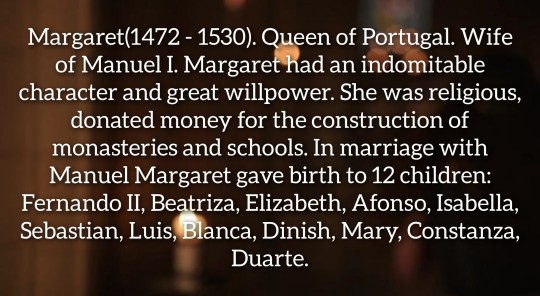
AU House of York: Children Edward IV and Elizabeth Woodville.
Elizabeth(1466 - 1520). Queen of France. Wife of Louis XII and mother of 10 children: Charles IX, Mary, Elizabeth, Louis, Madeleine, Jean, Guillaume, Philip, Jeanne and Bonne. Although their marriage was arranged for political reasons, it turned out to be a successful one. Elizabeth had no political influence as queen. She also devoted much attention to the education and upbringing of her children.
Mary(1467 - 1523). Queen of Denmark. Wife of Frederick I. Mary, as her older sister, was not interested in politics. The married life of Mary and Frederick was a happy one. He loved her for the fact that she did not interfere in his state affairs. They became the parents of 7 children: Christian III, Frederick II, Hans, Dorothea, Elisabeth, Dietrich and Anne.
Cecily(1469 - 1529). Queen of Scots. Wife of James IV, mother of 4 children: Marjorie, Anabella, Sibylla, Robert IV. The married life of the royal couple was not a happy one. Because of Jacob's constant infidelities, the couple became more and more distant from each other. The queen tried to influence the king's policy, but her attempts were unsuccessful.
Edward V(1470 - 1537). King of England. Husband of Isabella of Aragon. Edward's domestic and foreign policies were not successful. During his reign, nepotism and treasury increased in England, and he intervened in military conflicts of other countries. Isabella and Edward had a cool relationship. The marriage produced 5 children: Jacquetta, William IV, Isabella, Thomas and Henry.
Margaret(1472 - 1530). Queen of Portugal. Wife of Manuel I. Margaret had an indomitable character and great willpower. She was religious, donated money for the construction of monasteries and schools. In marriage with Manuel Margaret gave birth to 12 children: Fernando II, Beatriza, Elizabeth, Afonso, Isabella, Sebastian, Luis, Blanca, Dinish, Mary, Constanza, Duarte.
AU: Дети Эдуарда IV и Елизаветы Вудвилл.
Елизавета(1466 - 1520). Королева Франции. Жена Людовика XII и мать 10 детей: Карл IX, Мария, Елизавета, Людовик, Мадлен, Жан, Гильом, Филипп, Жанна и Бонна. Несмотря на то, что их брак был заключён по политическим соображениям, он оказался удачным. Елизавета не имела никакого политического влияния как королева. Также она уделял много внимая образованию и воспитанию своих детей.
Мария(1467 - 1523). Королева Дании. Жена Фредерика I. Марию, как её старшую сестру, не интересовала политика. Супружеская жизнь Марии и Фредерика была счастливой. Он полюбил её за то, что она не вмешивалась в его государственные дела. Они стали родителями 7 детей: Кристиан III, Фредерик II, Ганс, Доротея, Елизавета, Дитрих и Анна.
Сесилия(1469 - 1529). Королева Шотландии. Жена Якова IV, мать 4 детей: Марджори, Анабелла, Сибилла, Роберт IV. Супружеская жизнь королевской четы была не счастливой. Из-за постоянных измен Якова, супруги все дальше и дальше отдалялись друг от друга. Королева пыталась в влиять на политику короля, но её попытки остались без успешны.
Эдуард V(1470 - 1537). Король Англии. Муж Изабеллы Арагонской. Внутренняя и внешняя политика Эдуарда была не удачной. При его правлении в Англии увеличилось кумовство и казнокрадство, а также он вмешивался в военные конфликты других стран. У Изабеллы и Эдуарда были прохладные отношения. В браке родилось 5 детей: Жакетта, Вильгельм IV, Изабелла, Томас и Генрих.
Маргарита(1472 - 1530). Королева Португалии. Жена Мануэля I. У Маргарет был несгибаемый характер и большая сила воли. Была религиозна, жертвовала деньги на строительство монастырей и школ. В браке с Мануэлем Маргарита родила 12 детей: Фернанду II, Беатриса, Елизавета, Афонсу, Изабелла, Себастьян, Луиш, Бланка, Диниш, Мария, Констанса, Дуарте.
Part 1.
#history#history au#royal family#royalty#british royalty#british royal family#british#history of england#english history#england#english#house of york#au#elizabeth of york#the white princess#the white queen
9 notes
·
View notes
Photo

Karl Pavlovich Bryullov (Russian, 1799-1852)
The Death of Inês de Castro, Morganatic Wife of Don Pedro, Infant of Portugal, 1834
The Mikhailovsky Palace
The painting is based on an event from Portuguese history described in Luís de Cam es epic poem Os Lusíadas. Inês de Castro was the morganatic wife of Pedro, son of King Afonso IV who was killed by the courtiers lvaro Gonçalves, Pêro Coelho and Lopes Pacheco with the agreement of Alfonso IV. Karl Brullov is known to have painted the picture in the space of seventeen days in Milan in 1834. It was then exhibited at the Pinacoteca di Brera that same year.
#Karl Pavlovich Bryullov#ines des castro#Inês de Castro#world history#european history#art#fine art#russia#russian#iberia#portugal#europe#europa#european#european art#western civilization#blonde#woman
52 notes
·
View notes
Text

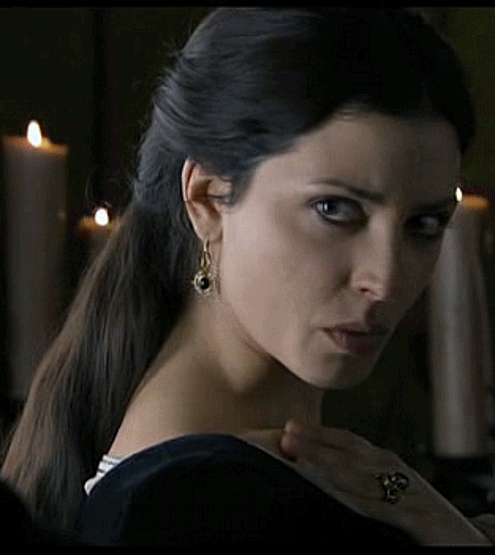

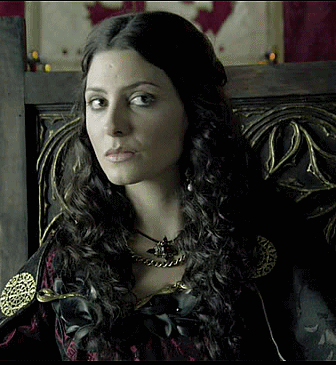
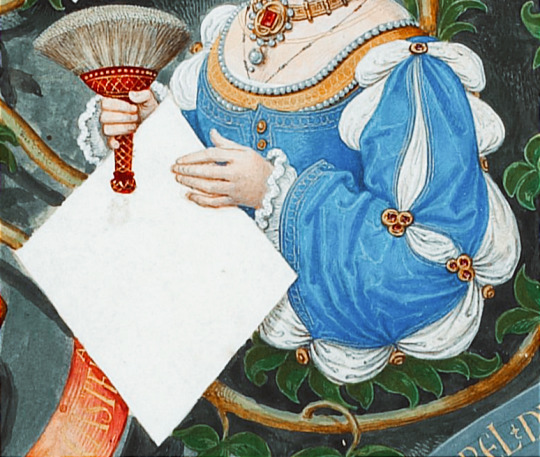
Juana of Portugal (1439-1475)
She was the posthumous daughter of King Duarte of Portugal and his wife Leonor of Aragon. Juana grew up in exile with her mother, due to the intrigues of the Portuguese court, and lived first at the Monastery of Santa María in Medina del Campo and later in Toledo, where Leonor of Aragon died. At the age of six, Juana returned to the Portuguese court of her brother Afonso V.
In 1455 the young Juana married her cousin Enrique IV of Castile, who had repudiated his first consort after thirteen years of marriage. The couple produced no children. The marriage was annulled on the grounds of an impotence that was specific rather than general, an impotence that applied only to Enrique’s relationship with Blanca of Navarre. Yet such an extraordinary explanation amounted to a case of maleficium (spell), with the clear implication that Blanca was the guilty party, and in addition she was obliged to leave Castile and return to Navarre.

Juana of Portugal was described as beautiful, cheerful and coquettish. The sources speak of the licentiousness introduced by the young Queen and her ladies in the austere Castilian court. They liked to use perfums, makeups, dresses that displayed too much décolletage, and flirting with men. One of her ladies, Guiomar de Castro, was King’s mistress, causing the anger of the Queen, and other, Mencía de Lemos, was Cardinal Mendoza’s mistress.
Six years after her wedding, Queen Juana was pregnant. Some say it was a miracle, others that it was the result of some sort of artificial insemination that the couple had tried, as was recorded by a german traveler. During this period, Juana insisted that Enrique's teenaged brother and sister, Alfonso and Isabel, forcefully be brought to the court and away from their sick mother. Many saw this as a way of making sure her daughter's path to the crown would encounter no obstacles. The Queen gave birth to a daughter named Juana, officially proclaimed heir to the Crown of Castile and created Princess of Asturias.
Queen Juana planned the marriage between her sister-in-law, Isabel of Castile, and her brother Afonso V of Portugal, and her daughter with her nephew Prince Joao. She wanted with these weddings an annexation of the Crown of Castile with the kingdom of Portugal.
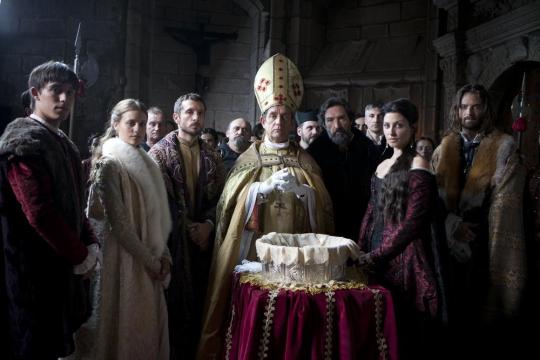
In early 1460s, Castilian nobles became dissatisfied with the rule of Enrique IV, and believed that Princess Juana was not King’s daughter. They called her la Beltraneja, a mocking reference to her supposed illegitimacy. Propaganda and rumour encouraged by the league of rebellious nobles argued that her father was Beltrán de la Cueva, a royal favorite of low background who had been elevated to enormous power by Enrique and who, by some, has been suggested as Enrique's lover.
Many nobles refused to recognise Princess Juana and preferred that Enrique instead name his younger half-brother, Alfonso as his heir. This was agreed to on the condition that Alfonso marries little Juana. Not long after this, Enrique reneged on his promise and began to support his daughter's claim once more. The nobles in league against him conducted a ceremonial deposition-in-effigy of Enrique outside the city of Avila and crowned Alfonso as a rival king.
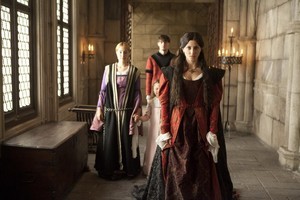
Queen Juana and her daughter were removed from the court. They lived in various castles as hostages, separately or together, protected by a faction of the nobility. The love affair of Queen Juana with the Bishop Fonseca’s nephew, Pedro of Castile, and the birth of her two illegitimate sons, caused great scandal. As a result of the need to conceal the pregnancy of her illegitimate sons, Juana of Portugal is considered the inventor of the farthingale.
In 1468, Alfonso of Castile died and Princess Juana was stripped of her succession-rights. Her aunt, Infanta Isabel, was placed before her, on condition that Isabel marry a man chosen out by the monarch. Queen Juana and her daughter sent a formal appeal to the Supreme Pontiff. Enrique accepted to divorce his wife and send her to Portugal, but Juana remained in Castile as king's wife, though separated of her husband. Isabel married Fernando of Aragon with the opposition of Enrique IV.
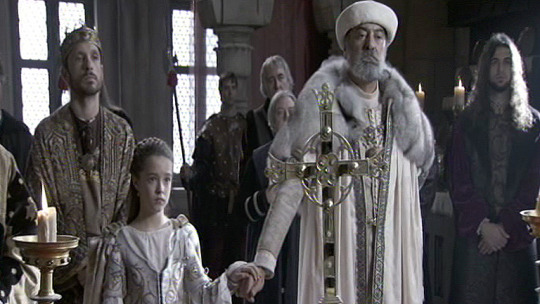
In 1470, Princess Juana was engaged and then married by proxy to the Duke of Guienne, brother of Louis XI of France. In the face of the French ambassador, King Enrique and Queen Juana swore before a crucifix that the Princess was their legitimate daughter. The French marriage never consummated, because the duke died two years later in France. Queen Juana always defended her daughter’s rights to the throne, and she had an active political participation. Queen Juana tried to get the support of nobles and cities, but with meager success and without palpable results. In 1474, Enrique IV died at the Alcázar of Madrid and rumors circulated that the late monarch had been poisoned, his wife and his daughter demanded an investigation. Queen Juana died a few months after her husband’s death at the age of 36. In the last months of her life, she lived at the convent of San Francisco in Madrid. The cause of her death is unknown.
Bárbara Lennie played Juana of Portugal in TV series "Isabel"
#juana de portugal#juana de avis#joan of portugal#women in history#spanish history#barbara lennie#Isabel tve#enrique IV#juana la beltranejs#juana de trastamara#juana de castilla
24 notes
·
View notes
Text
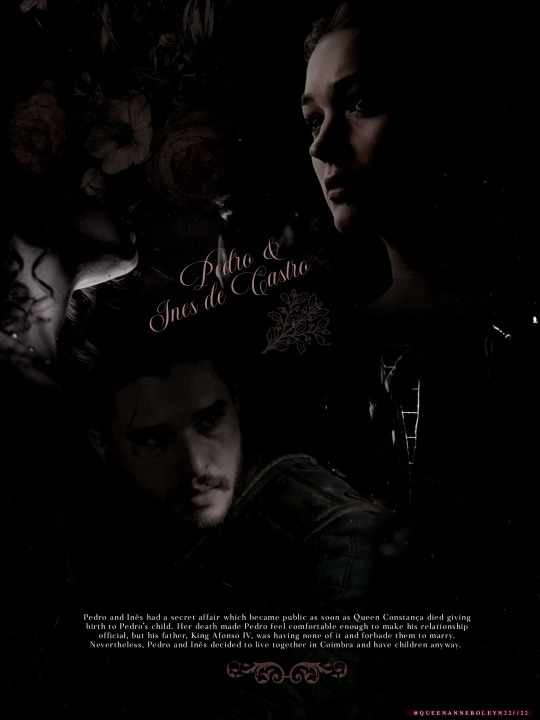
"There is a love story which has left a mark on the History of Portugal: the tale of forbidden love between Infante Peter and Inês de Castro, lady-in-waiting to his wife Constance. Although he was married, the Infante would have secret romantic meetings with Inês in the gardens of Quinta das Lágrimas. When Constance died in 1345, Peter and Inês lived as a married couple, a decision which angered King Afonso IV, his father, who was strongly opposed the relationship. The court and the people also disapproved of it.
Peter and Inês lived at Santa Clara Palace, in Coimbra, with their three children for many years. However, King Afonso IV, who was constantly under pressure because of the growing disapproval of the union within the court, decided to order the murder of Inês de Castro in January 1355. Deranged by pain, Peter led an uprising against the King and would never forgive his father for murdering his lover. When he finally took the crown in 1357, Peter ordered the arrest and execution of Inês’ murderers by ripping their hearts out. This action earned him the title of “the Cruel”. Later, after swearing that he had secretly married Inês de Castro, King Peter demanded that she be recognized as Queen of Portugal. In April 1360, he ordered the body of Inês to be moved from Coimbra to the Royal Monastery of Alcobaça, where two magnificent tombs were built so that he could rest next to his eternal lover forever."
Source: centerofportugal.com
#perioddramaedit#history#edit#history edit#pedro i#pedro of portugal#peter of portugal#ines de castro#portuguese history#14th century#sophia myles#kit harington#history lover#historian#historical figures#constance of portugal#alfonso iv of portugal#pedro e ines#pedro and ines#infante pedro#tragic love#love stories#historic love#women in history#historical
70 notes
·
View notes
Text
Queens and Princesses of the Spanish Kingdoms: Ages at First Marriage
I have only included women whose birth dates and dates of marriage are known within at least 1-2 years, therefore, this is not a comprehensive list. This data set ends with the transition to Habsburg-controlled Spain.
Sancha, wife of King Fernando I of Léon; age 14 when she married Fernando in 1032 CE
Ermesinda of Bigorre, wife of King Ramiro I of Aragon; age 21 when she married Ramiro in 1036 CE
Sancha, daughter of King Ramiro I of Aragon; age 18 when she married Count Ermengol III of Urgell in 1063 CE
Constance of Burgundy, wife of King Alfonso VI of Léon & Castile; age 19 when she married Count Hugh II of Chalon in 1065 CE
Felicia of Roucy, wife of King Sancho of Aragon; age 16 when she married Sancho in 1076 CE
Agnes of Aquitaine, wife of King Pedro I of Aragon; age 14 when she married Pedro in 1086 CE
Teresa, daughter of King Alfonso VI of Léon & Castile; age 13 when she married Count Henri of Burgundy in 1093 CE
Elvira, daughter of King Alfonso VI of Léon & Castile; age 15 when she married Count Raymond IV of Toulouse in 1094 CE
Bertha, wife of King Pedro I of Aragon; age 22 when she married Pedro in 1097 CE
Elvira, daughter of King Alfonso VI of Léon & Castile; age 17 when she married King Ruggero II of Sicily in 1117 CE
Berenguela of Barcelona, wife of King Alfonso VII of Léon & Castile; age 12 when she married Alfonso in 1128 CE
Urraca, daughter of King Alfonso VII of Léon; age 11 when she married King Garcia Ramirez of Navarre in 1144 CE
Petronilla, daughter of King Ramiro II of Aragon; age 14 when she married Count Ramon Berenguer IV of Barcelona in 1150 CE
Richeza of Poland, wife of King Alfonso VII of Léon & Castile; age 12 when she married Alfonso in 1152 CE
Sancha, daughter of King Alfonso VII of Léon & Castile; age 14 when she married King Sancho VI of Navarre in 1153 CE
Constanza, daughter of King Alfonso VII of Léon & Castile; age 16 when she married King Louis VII of France in 1154 CE
Urraca of Portugal, wife of King Fernando II of Léon; age 17 when she married Fernando in 1165 CE
Eleanor of England, wife of King Alfonso VIII of Castile; age 9 when she married Alfonso in 1170 CE
Sancha of Castile, wife of King Alfonso II of Aragon; age 20 when she married Alfonso in 1174 CE
Dulce, daughter of Queen Petronilla of Aragon; age 14 when she married King Sancho I of Portugal in 1174 CE
Berenguela, daughter of King Alfonso VIII of Castile; age 7 when she married Duke Conrad II of Swabia in 1187 CE
Marie of Montpellier, wife of King Pedro II of Aragon; age 10 when she married Viscount Raymond Geoffrey II of Marseille in 1192 CE
Garsenda of Foralquier, wife of Prince Alfonso II of Aragon; age 13 when she married Alfonso in 1193 CE
Constance of Toulouse, wife King Sancho VII of Navarre; age 15 when she married Sancho in 1195 CE
Constanza, daughter of King Alfonso II of Aragon; age 19 when she married King Emeric of Hungary in 1198 CE
Blanca of Castile, daughter of King Alfonso VIII of Castile; age 12 when she married King Louis VIII of France in 1200 CE
Eleonora, daughter of King Alfonso II of Aragon; age 22 when she married Count Raymond VI of Toulouse in 1204 CE
Urraca, daughter of King Alfonso VIII of Castile; age 19 when she married King Afonso II of Portugal in 1206 CE
Mafalda of Portugal, wife of King Enrique I of Castile; age 20 when she married Enrique in 1215 CE
Sancha, daughter of King Alfonso II of Aragon; age 25 when she married Count Raymond VII of Toulouse in 1211 CE
Elisabeth of Swabia, wife of King Fernando III of Castile; age 14 when she married Fernando in 1219 CE
Eleonora of Castile, wife of King Jaime I of Aragon; age 19 when she married Jaime in 1221 CE
Berenguela, daughter of King Alfonso IX of Léon; age 20 when she married Emperor Jean I of Brienne in 1224 CE
Marguerite of Bourbon, wife of King Teobaldo I of Navarre; age 15 when she married Teobaldo in 1232 CE
Yolanda of Hungary, wife of King Jaime I of Aragon; age 20 when she married Jaime in 1235 CE
Joan of Dammartin, wife of King Fernando III of Castile; age 17 when she married Fernando in 1237 CE
Yolanda, daughter of King Jaime I of Aragon; age 13 when she married King Alfonso X of Castile in 1249 CE
Isabelle of France, wife of King Teobaldo II of Navarre; age 14 when she married Teobaldo in 1255 CE
Kristina of Norway, wife of Prince Felipe of Castile; age 24 when she married Felipe in 1258 CE
Beatriz, daughter of King Teobaldo I of Navarre; age 16 when she married Duke Hugues IV of Burgundy in 1258 CE
Constanza, daughter of King Jaime I of Aragon; age 21 when she married Prince Manuel of Castile in 1260 CE
Constanza of Sicily, wife of King Pedro III of Aragon; age 13 when she married Pedro in 1262 CE
Isabel, daughter of King Jaime I of Aragon; age 14 when she married King Louis IX of France in 1262 CE
Beatrice of Savoy, wife of Prince Manuel of Castile; age 18 when she married Pierre of Chalon in 1268 CE
Blanche of France, wife of Prince Fernando of Castile; age 16 when she married Fernando in 1269 CE
Blanche of Artois, wife of King Enrique I of Navarre; age 21 when she married Enrique in 1269 CE
Beatriz, daughter of King Alfonso X of Castile; age 17 when she married Marquis William VII of Montferrat in 1271 CE
Esclaramunda of Foix, wife of King Jaime II of Majorca; age 25 when she married Jaime in 1275 CE
Maria de Molina, wife of King Sancho IV of Castile; age 17 when she married Sancho in 1282 CE
Yolanda, daughter of King Alfonso X of Castile; age 17 when she married Diego Lopez V de Haro in 1282 CE
Juana, daughter of King Enrique I of Navarre; age 11 when she married King Philippe IV of France in 1284 CE
Maria Diaz I de Haro, wife of Prince Juan of Castile; age 17 when she married Juan in 1287 CE
Yolanda, daughter of Prince Manuel of Castile; age 12 when she married Prince Afonso of Portugal in 1287 CE
Isabel, daughter of King Pedro III of Aragon; age 17 when she married King Denis of Portugal in 1288 CE
Isabel of Castile, wife of King Jaime II of Aragon; age 8 when she married Jaime in 1291 CE
Blanche of Anjou, wife of King Jaime II of Aragon; age 15 when she married Jaime in 1295 CE
Yolanda, daughter of King Pedro III of Aragon; age 24 when she married Prince Roberto of Naples in 1297 CE
Constanza of Portugal, wife of King Fernando IV of Castile; age 12 when she married Fernando in 1302 CE
Beatriz, daughter of King Sancho IV of Castile; age 16 when she married King Afonso IV of Portugal in 1309 CE
Maria, daughter of King Jaime II of Aragon; age 12 when she married Prince Pedro of Castile in 1311 CE
Constanza, daughter of King Jaime II of Aragon; age 12 when she married Prince Juan Manuel of Villena in 1312 CE
Teresa d'Entença, wife of King Alfonso IV of Aragon; age 14 when she married Alfonso in 1314 CE
Marie of Lusignan, wife of King Jaime II of Aragon; age 42 when she married Jaime in 1315 CE
Isabel, daughter of King Jaime II of Aragon; age 10 when she married King Frederick I of Germany in 1315 CE
Eleonora of Castile, wife of Prince Jaime of Aragon; age 12 when she married Jaime in 1319 CE
Elisenda of Montcada, wife of King Jaime II of Aragon; age 30 when she married Jaime in 1322 CE
Blanca de La Cerda y Lara, wife of Prince Juan Manuel of Castile; age 10 when she married Juan Manuel in 1327 CE
Constanza, daughter of King Alfonso IV of Aragon; age 18 when she married King Jaime III of Majorca in 1336 CE
Cecilia of Comminges, wife of Prince Jaime of Aragon; age 16 when she married Jaime in 1336 CE
Maria of Navarre, wife of King Pedro IV of Aragon; age 8 when she married Pedro in 1337 CE
Leonor of Portugal, wife of King Pedro IV of Aragon; age 19 when she married Pedro in 1347 CE
Eleonora of Sicily, wife of King Pedro IV of Aragon; age 24 when she married Pedro in 1349 CE
Juana Manuel, daughter of Prince Juan Manuel; age 11 when she married King Enrique of Castile in 1350 CE
Blanche of Bourbon, wife of King Pedro of Castile; age 14 when she married Pedro in 1353 CE
Constanza, daughter of King Pedro IV of Aragon; age 18 when she married King Federico of Sicily in 1361 CE
Maria de Luna, wife of King Martin of Aragon; age 14 when she married Martin in 1372 CE
Juana, daughter of King Pedro IV of Aragon; age 29 when she married Count Juan I of Ampurias in 1373 CE
Marthe of Armagnac, wife of King Juan I of Aragon; age 26 when she married Juan in 1373 CE
Beatriz of Portugal, wife of Prince Sancho of Castile; age 19 when she married Sancho in 1373 CE
Eleonora of Aragon, daughter of King Pedro IV of Aragon; age 17 when she married King Juan I of Castile in 1375 CE
Eleonora, daughter of King Enrique II of Castile; age 12 when she married King Carlos III of Navarre in 1375 CE
Isabel of Portugal, wife of Count Alfonso Enriquez; age 13 when she married Alfonso in 1377 CE
Violant of Bar, wife of King Juan I of Aragon; age 15 when she married Juan in 1380 CE
Beatriz of Portugal, wife of King Juan I of Castile; age 10 when she married Juan in 1383 CE
Juana, daughter of King Juan I of Aragon; age 17 when she married Count Matthieu of Foix in 1392 CE
Eleonora of Albuquerque, wife of King Fernando I of Aragon; age 20 when she married Fernando in 1394 CE
Yolanda, daughter of King Juan of Aragon; age 19 when she married Duke Louis II of Anjou in 1400 CE
Blanca I of Navarre, wife of Prince Martin of Aragon; age 15 when she married Martin in 1402 CE
Juana, daughter of King Carlos III of Navarre; age 20 when she married Count Jean I of Foix in 1402 CE
Beatriz, daughter of King Carlos III of Navarre; age 14 when she married Count James II of La Marche in 1406 CE
Isabel, daughter of King Pedro IV of Aragon; age 31 when she married Count Jaime II of Urgell in 1407 CE
Margarita of Prades, wife of King Martin of Aragon; age 14 when she married Martin in 1409 CE
Maria of Castile, wife of King Alfonso V of Aragon; age 14 when she married Alfonso in 1415 CE
Catalina of Castile, wife of Prince Enrique of Aragon; age 15 when she married Enrique in 1418 CE
Isabel, daughter of King Carlos III of Navarre; age 24 when she married Jean IV of Armagnac in 1419 CE
Maria, daughter of King Fernando I of Aragon; age 17 when she married King Juan II of Castile in 1420 CE
Eleonora, daughter of King Fernando I of Aragon; age 26 when she married King Duarte of Portugal in 1428 CE
Agnes of Cleves, wife of Prince Carlos of Aragon; age 17 when she married Carlos in 1439 CE
Blanca II of Navarre, daughter of King Juan II of Aragon and Queen Blanca I of Navarre; age 18 when she married King Enrique IV of Castile in 1440 CE
Eleonora of Navarre, daughter of King Juan II of Aragon and Queen Blanca 1 of Navarre; age 15 when she married Count Gaston IV of Foix in 1441 CE
Juana Enriquez, wife of King Juan II of Aragon; age 19 when she married Juan in 1444 CE
Isabel of Portugal, wife of King Juan II of Castile; age 19 when she married Juan in 1447 CE
Joana of Portugal, wife of King Enrique IV of Castile; age 16 when she married Enrique in 1455 CE
Isabel I of Castile, wife of King Fernando II of Aragon; age 18 when she married Fernando in 1469 CE
Juana, daughter of King Enrique IV of Castile; age 13 when she married King Afonso V of Portugal in 1475 CE
Juana, daughter of King Juan II of Aragon; age 21 when she married King Fernando I of Naples in 1476 CE
Isabel, daughter of King Fernando II of Aragon; age 20 when she married Prince Afonso of Portugal in 1490 CE
Juana, daughter of King Fernando II of Aragon; age 22 when she married Felipe I of Castile in 1501 CE
Margaret of Austria, wife of Prince Juan of Aragon; age 17 when she married Juan in 1497 CE
Maria, daughter of King Fernando II of Aragon; age 18 when she married King Manuel I of Portugal in 1500 CE
Catalina, daughter of King Fernando II of Aragon; age 15 when she married Prince Arthur of England in 1501 CE
Germaine of Foix, wife of King Fernando II of Aragon; age 18 when she married Fernando in 1506 CE
112 women; average age at first marriage was 16. The eldest bride was 42 years old, and the youngest was 7.
6 notes
·
View notes
Text
Making this a separate post so I don’t go off on a tangent in that love stories post...
Pedro and Inês’ love story was set against a very chaotic historical backdrop (but I guess that’s the norm...) The below is an extremely summarised version:
- Pedro’s wife Constança was the daughter of a very powerful Castilian nobleman, and King Afonso IV of Portugal worried that her father could turn against him due to how his daughter was being treated. Afonso IV himself had actually invaded Castile some years earlier because King Alfonso XI of Castile had mistreated his wife Maria, who was Afonso IV’s daughter.
- Inês’ brothers' political influence over Pedro was met with discontent and worry by the Portuguese nobility, especially the possibility that Pedro was being encouraged by them to get involved in Castilian affairs.
- Afonso IV was also worried about the possibility of an attempt on the life of his only legitimate grandson, the frail prince Fernando, in favour of Inês’ healthier children. Afonso IV himself had had to go to war against his father to secure his succession rights, as his father had favoured an illegitimate son. That civil war had lasted 5 years.
- And that illegitimate son was Afonso Sanches, who was declared a traitor by Afonso IV and who fled to Castile and had a son called João Afonso de Albuquerque.
- And that João Afonso de Albuquerque was the leader of a rebellion against king Pedro I of Castile, and offered prince Pedro of Portugal the crown of Castile in exchange for his support. This meeting was facilitated by Inês.
- King Afonso IV was absolutely determined not to have Portugal dragged into a foreign civil war, and this is what sealed Inês’ fate; her beheading was a gruesome warning to Pedro.
In the end it seems like Afonso IV only managed to delay the inevitable. His grandson king Fernando I of Portugal took after Pedro not only in matters of the heart, but he actually meddled in Castilian affairs, which led to the unsuccessful Fernandine wars and the ultimate end of the first dynasty and the interregnum. And then one of Pedro's illegitimate sons was crowned king anyway, just not any of those he had with Inês.
#lunie blabbers#this is absolutely irrelevant but did you know that Constança was first married to Alfonso XI of Castile?#who then got their marriage annulled (they'd been super young) so he could marry Maria#who was Pedro's older sister....the Pedro who Constança would later marry.....#history is wild. you can't make this up.#pedro and constança and inês were also all each other's cousins. which isn't as wild but i never knew that#i do respect invading castile cos your son-in-law is being an absolute dick to your daughter though i can't fault afonso iv for that
3 notes
·
View notes
Text
Day 2: Beatrice of Castile
Beatrice of Castile (also spelled Beatriz)
Born: 1293
Died: 25 October 1359
Parents: Sancho IV and María de Molina
Infanta of Castile
Queen of Portugal as the wife of Afonso IV ( 7 January 1325 – 28 May 1357)
Children: Maria (1313 – 18 January 1357) - the wife of Alfonso XI of Castile and mother of the future king Peter I of Castile.
Alfonso (1315– 1317)
Denis (born 12 February 1317) - died a few months after his birth
Peter (8 April 1320 – 18 January 1367) - King of Portugal
Isabel (21 December 1324 – 11 July 1326)
John (23 September 1326 – 21 June 1327)
Eleanor (1328 – 1348) - the wife of Peter IV of Aragon
She was born in Toro, Kingdom of Castile.
On 13 September 1297, the Treaty of Alcañices was signed by her mother, regent at the time, and the King of Portugal. The treaty included marriage clauses to reinforce the peace.
The four year old Beatrice abandoned Castile the same year to move to the Portuguese court where she was raised alongside her future spouse , Infante Afonso, who was 2 years her senior. She was raised in a refined environment, courtesy of her future father-in-law King Denis of Portugal.
Upon her arrival, she was given multiple wedding tokens including properties by the king. After marriage the number of estates increased, her husband gifting her a great number before even ascending the throne. She received even more properties after her son became king.
Before the marriage could take place a papal dispensation was required.
The papal bull was issued in 1301 but the marriage was postponed until Beatrice and Alfonso were of age.
In 1309 the two were married, aged 16 and 18. The marriage was celebrated in Lisbon on 12 September 1309. The marriage was happy and successful, Alfonso did not have a single child out of wedlock. The couple had 7 children, 3 living past infancy.
She played an important role in the affairs of the kingdom, mediated numerous conflicts, founded a hospital and left numerous properties and sums to religious establishments.
She had 7 children, only 3 reaching adulthood.
Beatrice died aged 66 in Lisbon. She is buried in Lisbon Cathedral next to her husband.
#portuguese history#spanish history#women history#history#medieval history#14th century#1300s#13th century
0 notes
Text
INES DE CASTRO
INES DE CASTRO
1325-1355
Inês de Castro was a Galician noblewoman and courtier, who became the mistress of King Pedro I of Portugal, who made her his queen after she died.
Pedro was the son of Afonso IV of Portugal who ruled from 1325-1357. Pedro was married to Constanza Manuel but fell in love his wife’s lady-in-waiting, Ines. After his wife died giving birth to their third child, he started living openly with Ines, and openly declared that he was the father of her children and refused to remarry unless he could marry Ines. King Afonso wanted Pedro to remarry a princess and wouldn’t allow him to marry Ines, so Pedro married Ines without his father’s permission.
At the end of Afonso’s life, he was worried about what would take place after his death so he ordered Ines to be imprisoned and then had her murdered in 1355 by a group of royal councillors, she was aged 29. He did this in the hope that his son would marry a princess, but Pedro was enraged when he learned that Ines was decapitated in front of their youngest child.
Afonso died and Pedro became king, one of his first actions was to have Ines assassins tortured, had their hearts torn from their bodies whilst they were still alive, and he became known as ‘Pedro the Cruel’. Now that he was king he wanted to make Ines his queen. He had her body exhumed, dressed in royal robes, and taken on a ceremonial, candlelit procession to her coronation, where she was anointed and then crowned. He demanded that his subjects swear allegiance to their new queen, and one by one each noble came forward, knelt, and kissed her hand.
She was later buried at the Monastery of Alcobaca in a beautiful marble tomb, opposite Peter’s so in legend that they can rise from their graves and look at each other. On the marble coffin there is a promise by Pedro that they would be ‘together until the end of the world’.


#inesdecastro #peterIofportugal
1 note
·
View note
Text
Events (before 1900)
306 – Constantine I is proclaimed Roman emperor by his troops.
315 – The Arch of Constantine is completed near the Colosseum in Rome to commemorate Constantine I's victory over Maxentius at the Milvian Bridge.
677 – Climax of the Siege of Thessalonica by the Slavs in a three-day assault on the city walls.
864 – The Edict of Pistres of Charles the Bald orders defensive measures against the Vikings.
1137 – Eleanor of Aquitaine marries Prince Louis, later King Louis VII of France, at the Cathedral of Saint-André in Bordeaux.
1139 – Battle of Ourique: The Almoravids, led by Ali ibn Yusuf, are defeated by Prince Afonso Henriques who is proclaimed King of Portugal.
1261 – The city of Constantinople is recaptured by Nicaean forces under the command of Alexios Strategopoulos, re-establishing the Byzantine Empire.
1467 – The Battle of Molinella: The first battle in Italy in which firearms are used extensively.
1536 – Sebastián de Belalcázar on his search of El Dorado founds the city of Santiago de Cali.
1538 – The city of Guayaquil is founded by the Spanish Conquistador Francisco de Orellana and given the name Muy Noble y Muy Leal Ciudad de Santiago de Guayaquil.
1547 – Henry II of France is crowned.
1554 – The royal wedding of Mary I and Philip II of Spain celebrated at Winchester Cathedral.
1567 – Don Diego de Losada founds the city of Santiago de Leon de Caracas, modern-day Caracas, the capital city of Venezuela.
1591 – The Duke of Parma is defeated near the Dutch city of Nijmegen by an Anglo-Dutch force led by Maurice of Orange.
1593 – Henry IV of France publicly converts from Protestantism to Roman Catholicism.
1603 – James VI and I and Anne of Denmark are crowned in Westminster Abbey.
1609 – The English ship Sea Venture, en route to Virginia, is deliberately driven ashore during a storm at Bermuda to prevent its sinking; the survivors go on to found a new colony there.
1668 – A magnitude 8.5 earthquake strikes eastern China, killing over 42,000 people.
1693 – Ignacio de Maya founds the Real Santiago de las Sabinas, now known as Sabinas Hidalgo, Nuevo León, Mexico.
1718 – At the behest of Tsar Peter the Great, the construction of the Kadriorg Palace, dedicated to his wife Catherine, begins in Tallinn.
1722 – Dummer's War begins along the Maine-Massachusetts border.
1783 – American Revolutionary War: The war's last action, the Siege of Cuddalore, is ended by a preliminary peace agreement.
1788 – Wolfgang Amadeus Mozart completes his Symphony No. 40 in G minor (K550).
1792 – The Brunswick Manifesto is issued to the population of Paris promising vengeance if the French royal family is harmed.
1797 – Horatio Nelson loses more than 300 men and his right arm during the failed conquest attempt of Tenerife (Spain).
1799 – Napoleon Bonaparte defeats a numerically superior Ottoman army under Mustafa Pasha at the Battle of Abukir.
1814 – War of 1812: An American attack on Canada is repulsed.
1824 – Costa Rica annexes Guanacaste from Nicaragua.
1837 – The first commercial use of an electrical telegraph is successfully demonstrated in London by William Cooke and Charles Wheatstone.
1853 – Joaquin Murrieta, the famous Californio bandit known as the "Robin Hood of El Dorado", is killed.
1866 – The United States Congress passes legislation authorizing the rank of General of the Army. Lieutenant General Ulysses S. Grant becomes the first to be promoted to this rank.
1868 – The Wyoming Territory is established.
1869 – The Japanese daimyōs begin returning their land holdings to the emperor as part of the Meiji Restoration reforms. (Traditional Japanese Date: June 17, 1869).
1894 – The First Sino-Japanese War begins when the Japanese fire upon a Chinese warship.
1897 – American author Jack London embarks on a sailing trip to take part in the Klondike's gold rush, from which he wrote his first successful stories.
1898 – Spanish–American War: The American invasion of Spanish-held Puerto Rico begins, as United States Army troops under General Nelson A. Miles land and secure the port at Guánica.
0 notes
Text
January 07

[1528] Jeanne d'Albret, Queen of Navarre (1555-72), mother of French King Henry IV.
[1768] Joseph Bonaparte, French King of Naples and Spain, brother of Napoleon, born in Corte, Corsica.
[1796] Charlotte Augusta of Wales, British Princess and only legitimate grandchild of King George III, born in London.
[1845] Ludwig III, last King of Bavaria (1913-18), born in Munich, Bavaria.
[1926] Joe Marston, Australian football defender, born in Leichhardt, New South Wales, Australia.
[1929] Mario Bergamaschi, Italian football midfielder, born in Crema, Italy.
[1939] Prince Michael of Greece and Denmark, born in Rome, Kingdom of Italy.
[1964] Nicolas Cage, American actor, born in Long Beach, California.
[1970] João Ricardo, Angolan football goalkeeper, born in Luanda, Angola.
[1971] Jeremy Renner, American actor, born in Modesto, California.
[1977] Dustin Diamond, American actor and stand-up comedian, born in San Jose, California.
[1982] Lauren Cohan, British-American actress, born in Cherry Hill, New Jersey.
[1983] Brett Dalton, American actor, born in San Jose, California.
[1986] Grant Leadbitter, English football midfielder, born in Chester-le-Street, United Kingdom.
[1987] Davide Astori, Italian football central defender, born in San Giovanni Bianco, Italy.
[1989] Emiliano Insúa, Argentine football left-back, born in Buenos Aires, Argentina.
[1991] Eden Hazard, Belgian football winger or attacking midfielder, born in La Louvière, Belgium.
[2012] Blue Ivy Carter, American daughter of Beyoncé and Jay-Z, born in New York City, New York.

[312] Lucian of Antioch, theologist and martyr, dies from torture and starvation at 72.
[1285] Charles I of Anjou, King of Naples and Sicily (1266-85), brother of King Louis IX of France, dies at 58.
[1325] Denis of Portugal, King of Portugal (1279-1325), dies at 63.
[1355] Inês de Castro, Galician noblewoman, lover and posthumously-recognized wife of King Peter I of Portugal, is murdered in the orders of King Afonso IV at 29 or 30.
[1536] Catherine of Aragon, 1st wife of King Henry VIII, mother of Queen Mary 1, dies at 50.
[1695] Mary II, Queen of England, Scotland and Ireland, wife of King William III, dies of smallpox at 32 (OS=Dec. 28, 1694).
[1743] Anne Sophie von Reventlow, Queen of Denmark and Norway (1721-30), dies at 49.
[1830] Infanta Carlota Joaquina, daughter of King Charles IV of Spain and wife of King John VI of Portugal, dies at 53.
[1890] Augusta of Saxe-Weimar-Eisenach, wife of German Emperor William I, dies at 78.
[1922] Jonah Kūhiō Kalaniana'ole, Prince of the Kingdom of Hawaii, dies at 50.
[1943] Nikola Tesla, Serbian-American physicist,electrical engineer and inventor who developed alternating current and the Tesla Coil, dies at 86.
[1989] Emperor Shōwa (Hirohito), 124th Emperor of Japan (1926-89), dies at 87 after a 62-year reign.
[2020] Khamis Al-Owairan, Saudi Arabian football midfielder, dies from cancer at 46.
#on this day in history#on this day#otdih#otd#football history#football#january#january 07#birthdays#rest in peace#nicolas cage#jeremy renner#dustin diamond#lauren cohan#brett dalton#eden hazard#joseph bonaparte#blue ivy carter#beyoncé#jay z#peter i of portugal#catherine of aragon#mary ii#nikola tesla#emperor hirohito
0 notes
Text









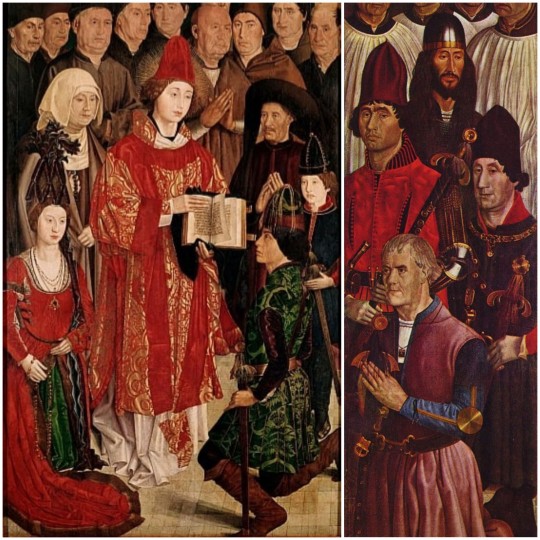
The Bastard Kings and their families
This is series of posts are complementary to this historical parallels post from the JON SNOW FORTNIGHT EVENT, and it's purpouse to discover the lives of medieval bastard kings, and the following posts are meant to collect portraits of those kings and their close relatives.
In many cases it's difficult to find contemporary art of their period, so some of the portrayals are subsequent.
1) John I of Portugal (1357 – 1433), son of Peter I of Portugal and Teresa Lourenço; with his wife, Philippa of Lancaster (1360 – 1415), daughter of John of Gaunt and his wife Blanche of Lancaster
2) His father, Peter I of Portugal (1320 – 1367), son of Afonso IV of Portugal and his wife Beatrice of Castile
3) His sister, Beatrice of Portugal (c. 1354–1381), daugther of Peter I of Portugal and his wife Inês de Castro
4) His brother, John of Portugal (1352 – c. 1396), son of Peter I of Portugal and his wife Inês de Castro
5) His brother, Ferdinand I of Portugal (1345 – 1383), son of Peter I of Portugal and his wife Constanza Manuel de Villena
6) His sister in law, Leonor Teles de Meneses (c. 1350 – c. 1405), daughter of Martim Afonso Telo de Meneses and his wife Aldonça Eanes de Vasconcelos
7) His niece, Beatrice of Portugal (1373 –c. 1420), daughter of Ferdinand I of Portugal and his wife Leonor Teles de Meneses
8) His niece, Isabella of Portugal (1364–1395), daughter of Ferdinand I of Portugal and an unknown woman
9) His daughter with Philippa of Lancaster, Isabella of Portugal (1397 – 1471)
10) Left:
I. Eleanor of Aragon (1402 – 1445), daughter of Ferdinand I of Aragon and his wife Leonor de Albuquerque; and wife of Edward I of Portugal
II. Isabella of Coimbra (1432 – 1455), daughter of Peter of Portugal and Isabella of Urgell; wife of Afonso V of Portugal
III. Edward I of Portugal (1391 – 1438), son of John I of Portugal and his wife Philippa of Lancaster
IV. John II of Portugal (1455 – 1495), son of Afonso V of Portugal and his wife Isabella of Coimbra
V. Afonso V of Portugal 15 (1432 – 1481), son of Edward I of Portugal and his wife Eleanor of Aragon
Right:
I. Ferdinand of Portugal (1402 – 1443), son of John I of Portugal and his wife Philippa of Lancaster
II. John of Portugal (January 1400 – 1442) son of John I of Portugal and his wife Philippa of Lancaster
III. Peter of Portugal (1392 – 1449), son of John I of Portugal and his wife Philippa of Lancaster
IV. Henry of Portugal (1394 – 1460), son of John I of Portugal and his wife Philippa of Lancaster
Note: In the last picture, the Panel of the Prince or the Infante and the Panel of the Knights from Nuno Gonçalves' St. Vincent Panels, the identity of some of the members of the Royal family it's still discussed, like the man identified as Edward I in the Panel of the Prince is his brother Henry, but we're considering the interpretation of the people of the panel being Afonso V with his parents, wife and heir, and the ones of the Panel of the Knights are Edward I's brothers, although by the time the panels were painted most of them have already died.
#jonsnowfortnightevent2023#asoiaf#a song of ice and fire#day 10#echoes of the past#historical parallels#medieval bastard kings#bastard kings and their families#john i of portugal#philippa of lancaster#peter i of portugal#ferdinand i of portugal#beatrice of portugal#john of portugal#isabella of portugal#eleanor of aragon#edward i of portugal#john ii of portugal#afonso v of portugal#leonor teles de meneses#isabella of coimbra#peter of coimbra#canonjonsnow
11 notes
·
View notes
Photo










Lisbon Cathedral (No. 5)
At the end of the 13th century King Dinis of Portugal ordered the construction of a cloister in Gothic style, which became severely damaged by the 1755 earthquake. Near the entrance of the cathedral, a rich merchant, Bartolomeu Joanes, built a funerary chapel for himself in the beginning of the 14th century. His tomb with his laying figure is still inside. Somewhat later, King Afonso IV of Portugal had the Romanesque apse replaced by a Gothic main chapel surrounded by an ambulatory with radiating chapels. The king and his family were buried in the main chapel, but their tombs and the chapel itself were destroyed in the 1755 earthquake. The ambulatory has survived and is an important work in the history of Portuguese Gothic. It consists of a circular aisle – not connected to the main chapel – with a series of radiating chapels. The second storey of the ambulatory is covered by ribbed vaulting and has a series of windows (clerestory) that bathe the interior with abundant light.
The ambulatory contains three outstanding Gothic tombs from the mid-14th century. One tomb belongs to Lopo Fernandes Pacheco, 7th Lord of Ferreira de Aves, a nobleman at the service of King Afonso IV. His laying figure appears holding his sword and is guarded by a dog. His wife, Maria de Vilalobos, appears over her tomb reading a Book of Hours. The third tomb belongs to an unidentified royal princess. All tombs are decorated with coats-of-arms.
In the last quarter of the 15th century it is believed that the famous Saint Vincent Panels, painted by Nuno Gonçalves, were placed in the St Vincent chapel of the ambulatory. They remained there at least until 1690 and were set aside in the Cathedral until 1742. They were then transferred to the palace of Mitra. The panels are now in the Museu Nacional de Arte Antiga (National Museum of Ancient Art) in Lisbon.
Source: Wikipedia
#Cathedral of Saint Mary Major#Santa Maria Maior de Lisboa#Lisboa#Lisbon#Metropolitan Cathedral of St. Mary Major#Sé de Lisboa#Portugal#interior#architecture#cityscape#original photography#summer 2021#landmark#tourist attraction#vacation#Southern Europe#stained glass window#ceiling#column
1 note
·
View note